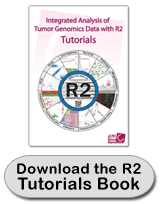|
| Info Welcome to the Sample Maps module of R2. Sample Maps are scatterplots of samples. Often the coordinates of a sample map are copied embeddings from a scientific article or are created with a dimension reduction algorithm, such as t-SNE or UMAP. In the selection grid you can find the source of the coordinates in the column Map type.
R2 offers several machine learning dimensionality reduction algorithms that are well suited for the reduction of high dimensional datasets to just 2 or 3 dimensions. Samples that have similar expression profiles in a dataset are located closely together on the 2D or 3D map, which enables the user to find clusters of similar samples. The R2 team often adds maps for public datasets into R2. Users can send a request to the R2 Team to generate maps for a specific dataset, or to add the coordinates from another source. From the main page, users with collaborator access or higher access level can generate themselves t-SNE maps for datasets or subsets within a dataset. Since running the t-SNE algorithm is a time consuming task and can take up to hours of processing time for large datasets, R2 stores the results for every run that has been completed. All users of R2 can explore previously generated t-SNE maps of datasets that they have access to. By default, UMAP and t-SNE maps that are created on the platform or by the R2 Team are run with a range of values for their most important parameters. The different resulting embeddings for the dataset are accessible once the default map is selected from the grid. UMAP and t-SNE plots often look pretty, however be sure to understand some of the basic properties before you interpret the result. We warmly recommend the following blog post on T-SNE behaviour here. You can find a chapter in the R2 Tutorial about Sample maps where we describe how to explore sample maps on our platform. |


